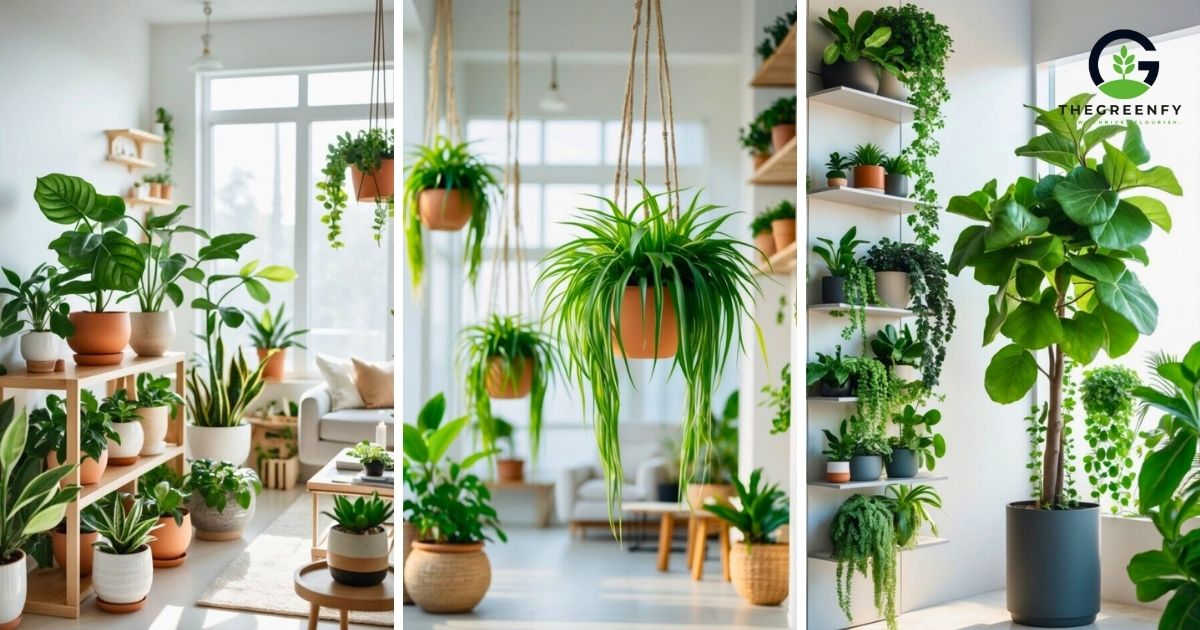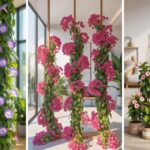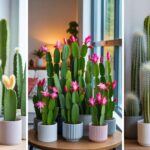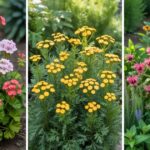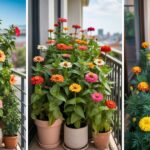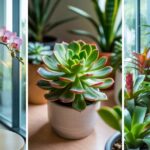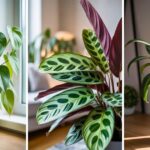House plants can totally change the mood of any room. I’ve found that adding a little greenery is the easiest way to brighten up your home and make it feel welcoming.
Even a small corner can spring to life with the right plant. Whether you’ve got a big space or just a windowsill, plants bring color and energy everywhere.
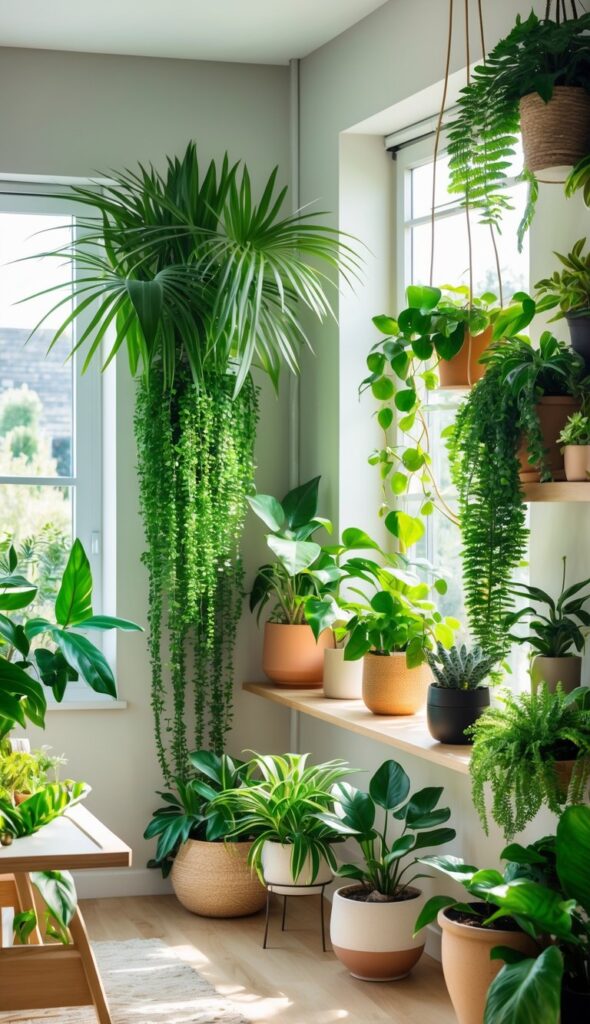
The best part about decorating with house plants is how flexible and fun it is. You don’t need to be a plant expert—honestly, just a little curiosity and a few pots go a long way.
Let’s dive into 15 ideas I actually use to keep my space feeling fresh and creative. Hope you find something that sparks inspiration!
1. Create a trailing wall with Philodendron and Monstera
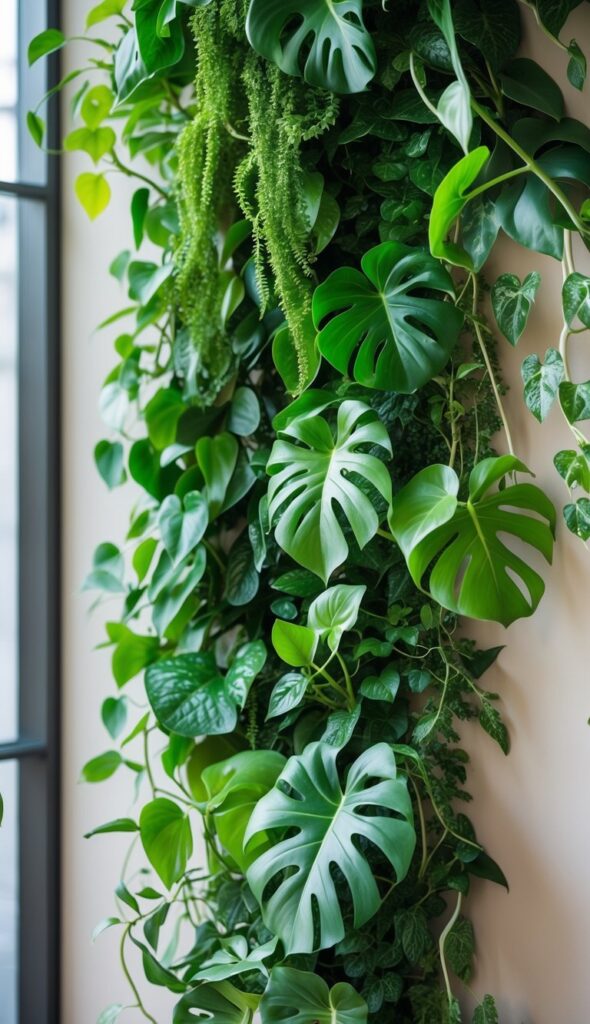
I love using Philodendron and Monstera to build a living wall. Their vines climb up wires or a trellis and look amazing.
Try hanging pots at different heights or let the vines trail from a clothes rack. It saves space and really brings the outdoors in.
2. Use command hooks to train vines up concrete walls
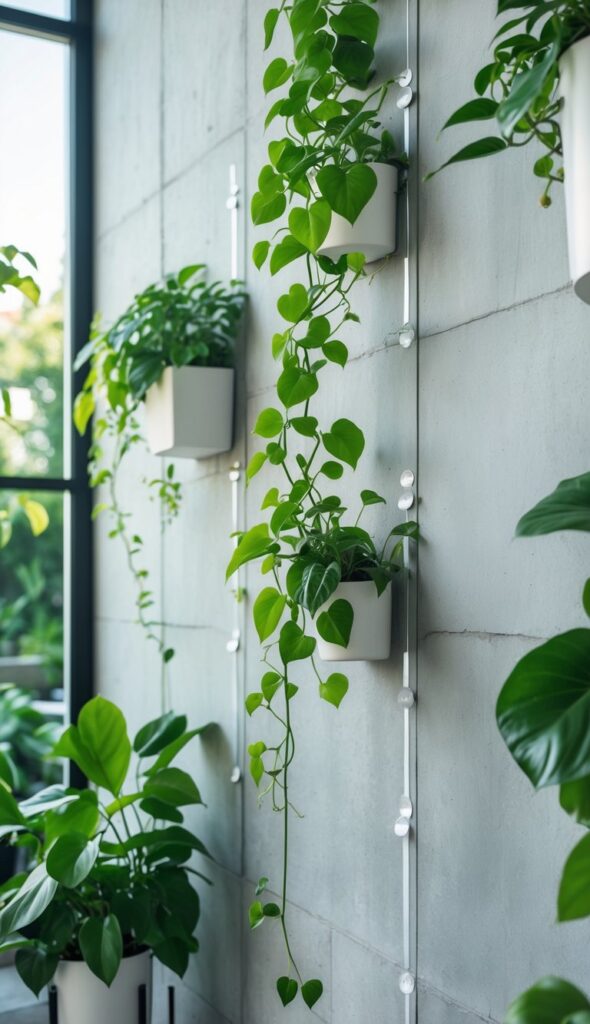
I use command hooks to guide my vines on concrete walls. They stick without leaving marks—no tools needed.
Just press them on clean, dry spots and arrange them however you like. The clear hooks don’t steal the show, and you can use a bunch without worrying about holes everywhere.
3. Hang spider plants for fun cascading greenery
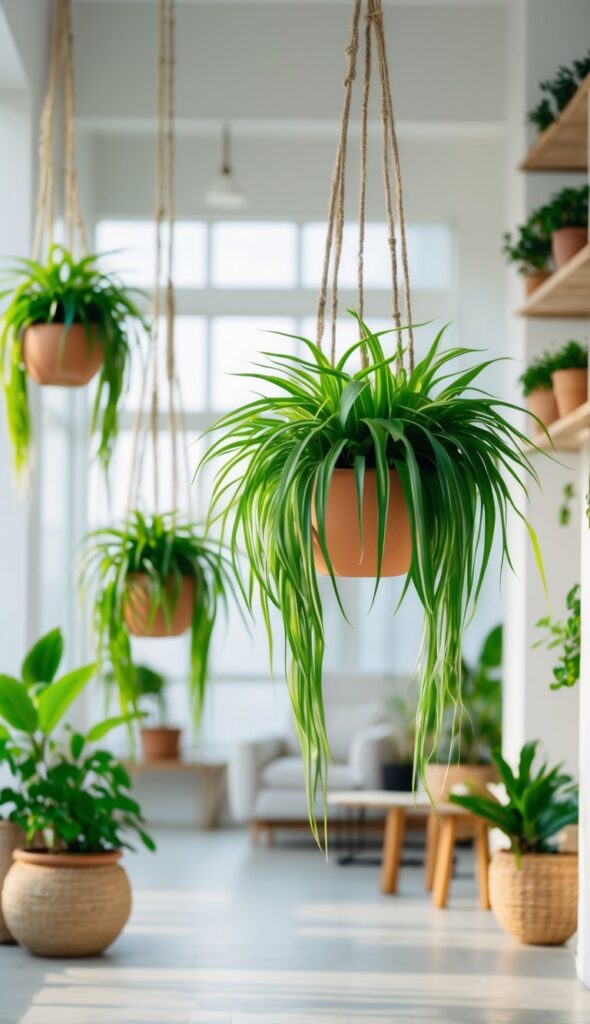
Spider plants are my go-to for hanging baskets because their leaves just spill over in the best way. They’re perfect for corners or windowsills where space is tight.
They love bright, indirect light, but they’re not too picky. I keep mine out of direct sun to avoid crispy leaves.
Macramé holders or simple baskets do the trick. These plants are cheerful and forgiving—honestly, what’s not to love?
4. Display a tall Fiddle Leaf Fig by vertical shelves

Vertical shelves are perfect for showing off a tall Fiddle Leaf Fig. The plant’s upward growth pairs nicely with tall shelving.
I stagger shelf heights to keep things interesting. The fig stands out without making the room feel crowded.
5. Mix hanging and potted plants in kitchen windows
Combining hanging and potted plants in my kitchen window creates layers of green. It’s a great way to add life without losing counter space.
I hang pothos or ivy from the ceiling for a soft, trailing effect. On the sill, I tuck in smaller pots like aloe for a pop of green where the sun hits.
6. Incorporate macramé hangers for boho plant vibes
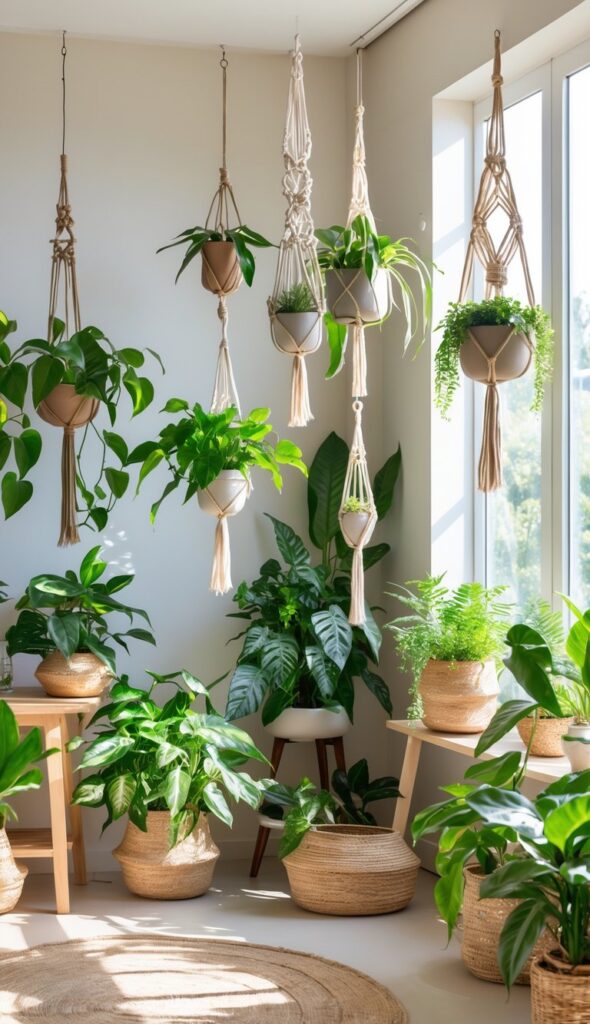
Macramé hangers bring instant boho vibes and save floor space. I hang plants from the ceiling or wall to keep things airy.
They come in all sorts of patterns and colors, so you can match your style. If you’re into DIY, making your own is surprisingly doable.
One maker told me, “Macramé plant hangers bring texture and warmth to any spot,” and honestly, I couldn’t agree more.
7. Group bird’s nest ferns for textured interest
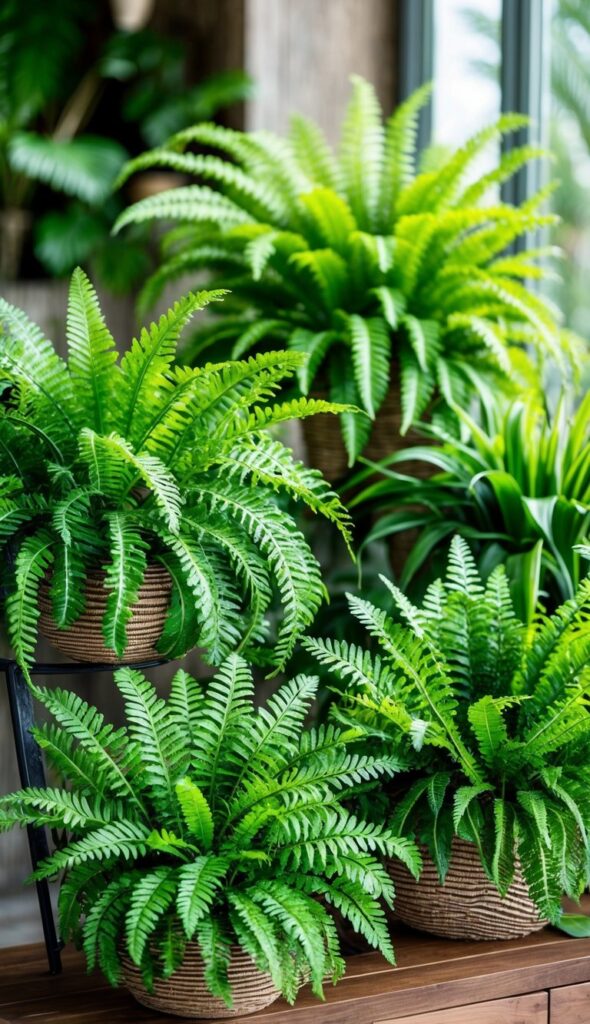
Bird’s nest ferns grouped together create a cool, textured look. Their wavy leaves naturally catch the eye.
Mix different sizes or stick to one for a calmer vibe. I like putting them on a shelf or in a corner for a lush, but not overwhelming, effect.
They thrive in indirect light and don’t need fancy care. Perfect for busy folks or anyone who forgets to water now and then.
8. Use light hooks to support climbing Scindapsus
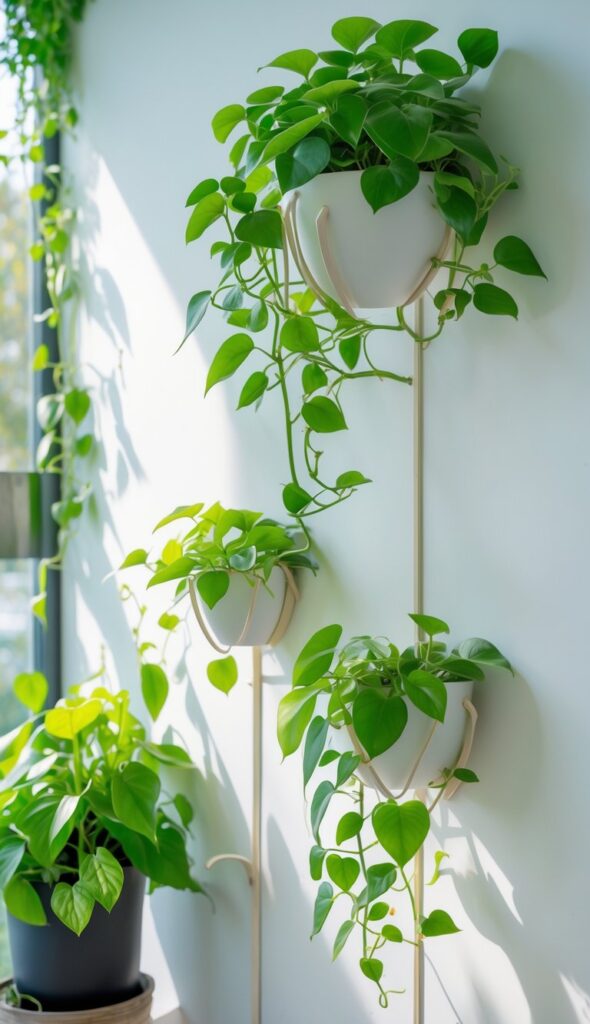
Light hooks are my secret for training Scindapsus vines up a wall. They’re easy to pop in and let you shape the plant however you like.
Attach the vines gently and let them climb or spread across. If you want, add little clips to hold the stems without hurting them.
9. Set up a mini Japanese-style indoor garden

Building a tiny Japanese-style garden indoors gives me a sense of calm. I start with a shallow tray or wooden box as the base.
Moss, bonsai, or succulents fit right in and barely need attention. Sometimes I add stones or sand for patterns—a bamboo bridge or little water basin if I’m feeling fancy.
It’s simple, but it creates a peaceful spot to just sit and breathe.
10. Adorn your dining table with low plant centerpieces
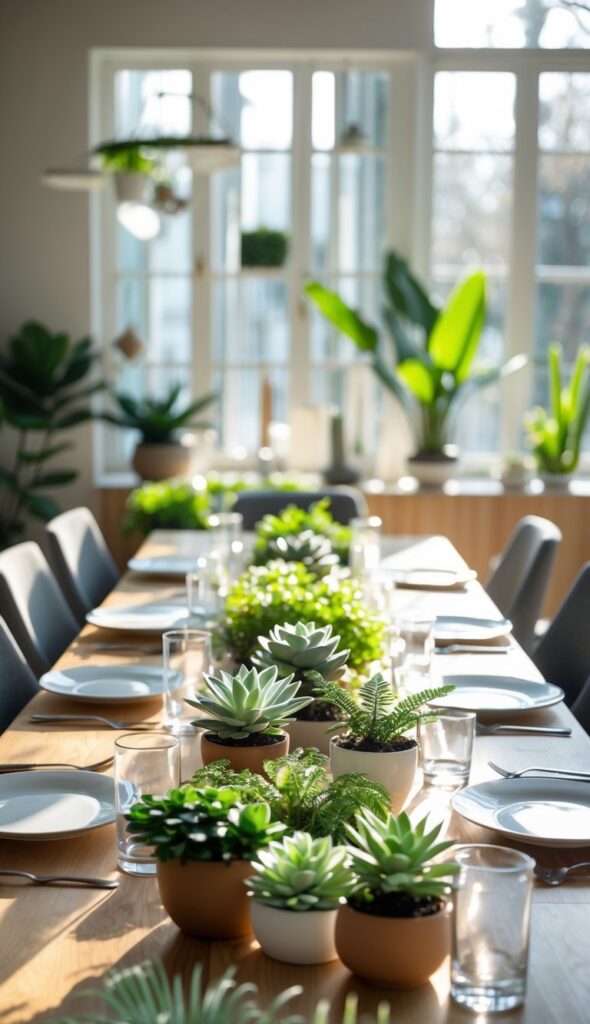
Low plant centerpieces are my trick for a lively dining table. They don’t block anyone’s view, which is key for good conversation.
Succulents or herbs work great. Sometimes I toss in a rosemary or eucalyptus bouquet for a little scent.
If you want something super easy, a small pothos in a shallow pot stays green and happy almost anywhere. These centerpieces keep things fresh without hogging space.
11. Place rubber plants to add lush, shiny leaves
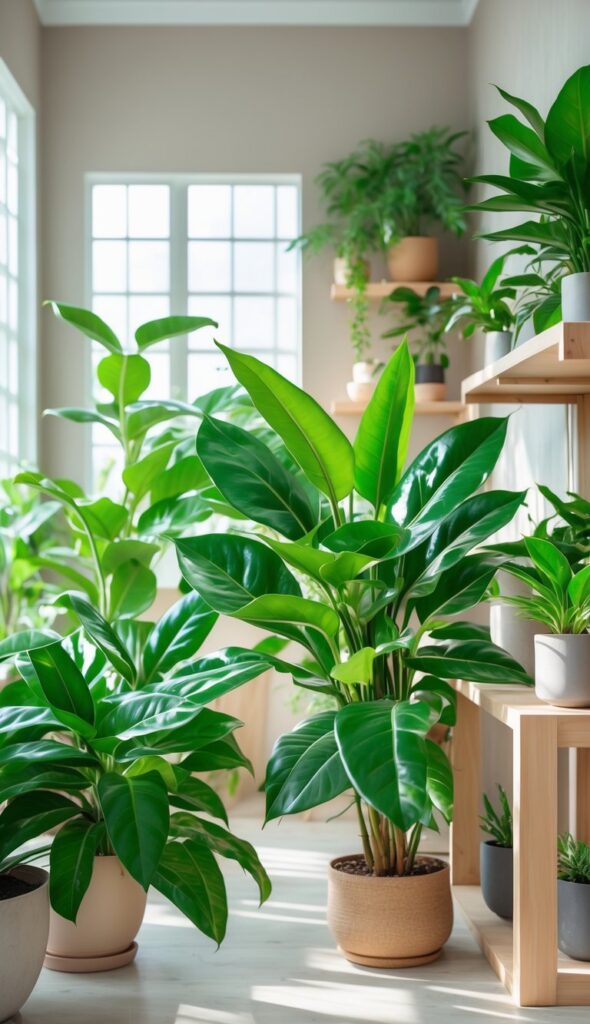
Rubber plants are all about those glossy, broad leaves. I put them where they catch bright, indirect light—they just shine.
They handle moderate humidity and temps between 65-85°F, so they’re pretty forgiving. Here’s what I do:
- Keep them near windows but out of direct sun
- Water when the top inch of soil is dry
- Wipe leaves gently to keep them looking their best
12. Arrange bird’s nest and asparagus ferns for wispy greens
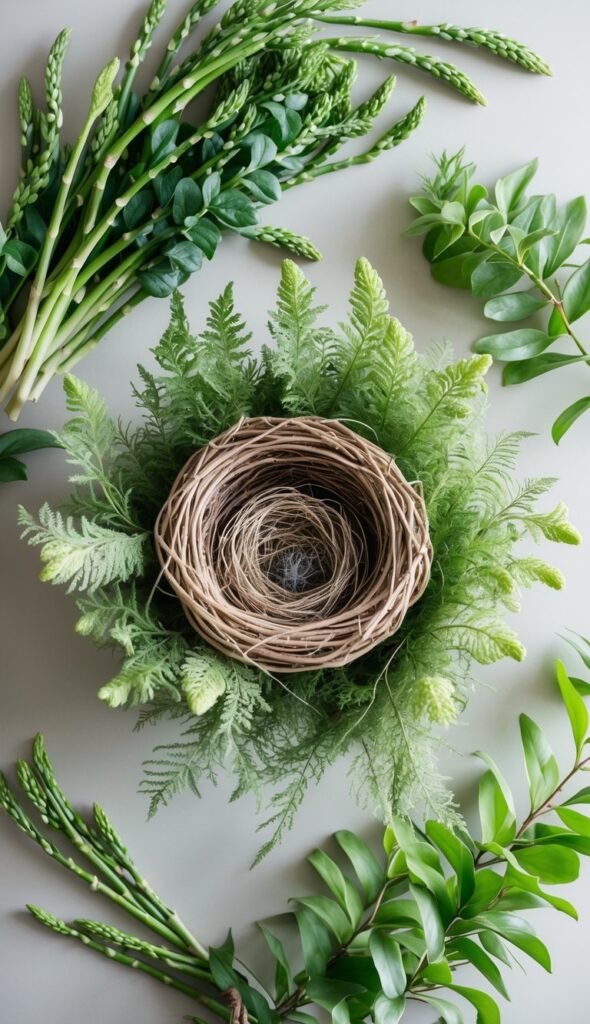
Mixing bird’s nest ferns with asparagus ferns gives a light, airy feel. The broad leaves of the bird’s nest pair well with the feathery asparagus fern.
I often pop them together in a pot or basket. Near a window with indirect light, they look amazing—and honestly, they’re pretty chill to care for.
13. Combine seasonal decor with small houseplants on tables
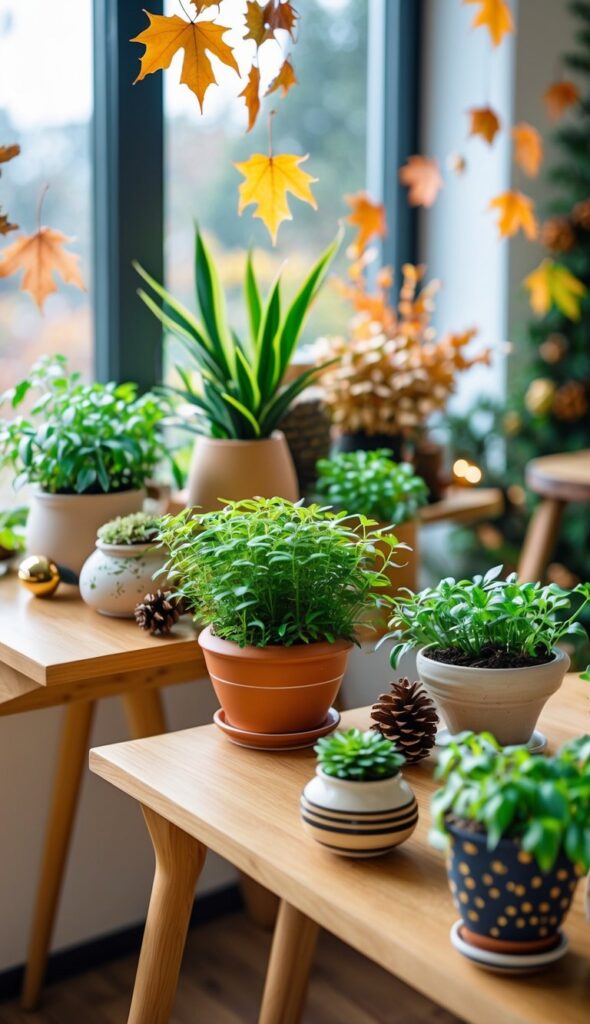
During holidays, I add small houseplants to my table for a fresh touch. Low plants keep things open for chatting and serving food.
I mix in pinecones for winter or colorful leaves in the fall. It’s a simple way to make the table feel festive and cozy.
Just a bit of green can really brighten up any get-together.
14. Create an indoor tropical jungle corner
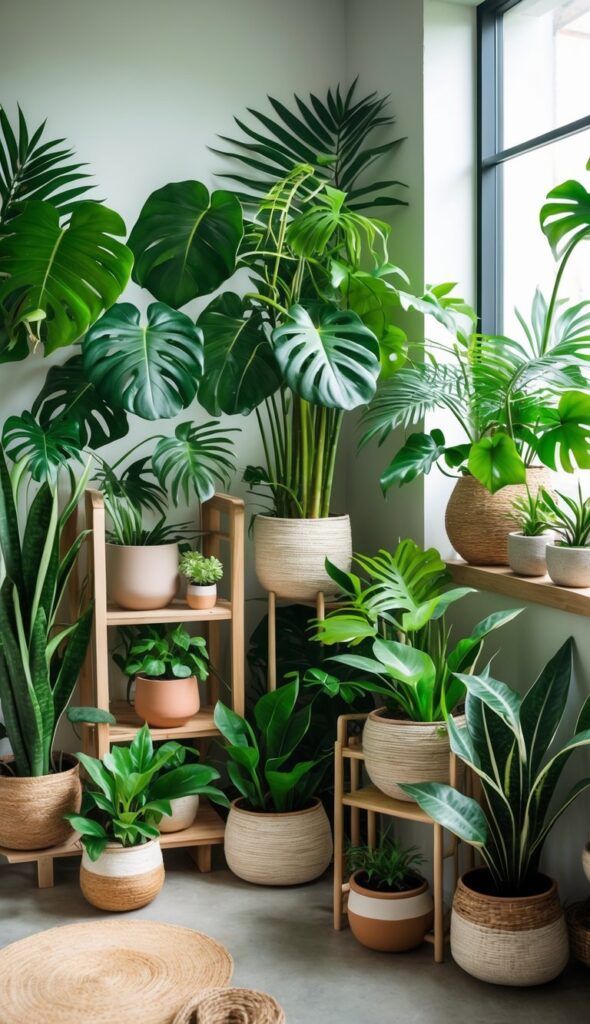
Picking a sunny spot for a tropical jungle corner totally transforms the vibe. I mix tall palms like Areca with rubber plants for height and glossy leaves.
Metal shelves help me stack pots and let vines climb. Toss in a rattan chair and it suddenly feels like a lush retreat—right at home.
• Use well-draining soil
• Water when the top soil is dry
• Skip standing water to keep roots happy
15. Position air-purifying plants in bedrooms
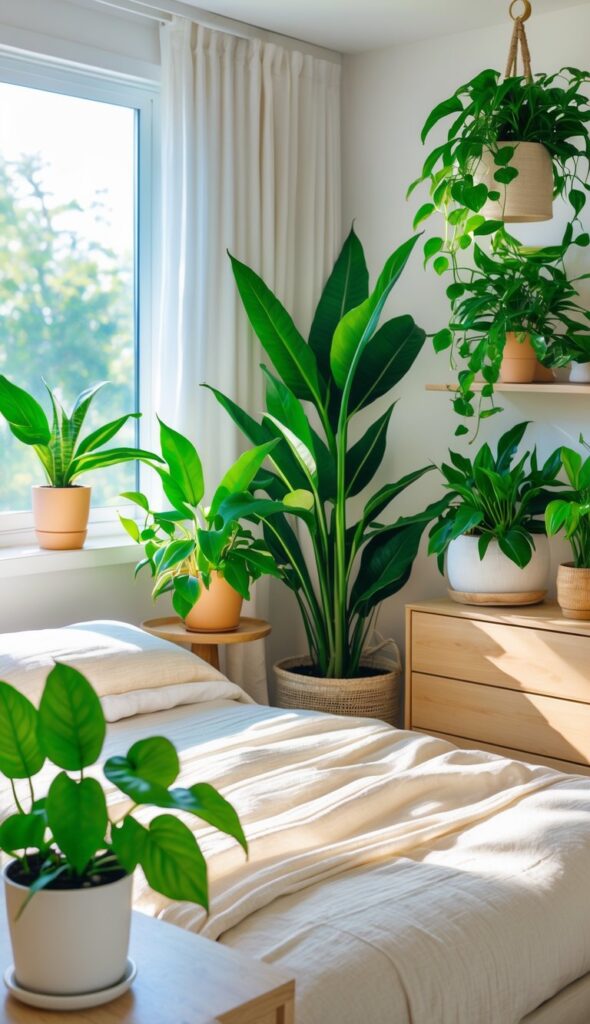
I love putting air-purifying plants in my bedroom. They soak up some toxins and kick out fresh oxygen, so my room always feels a bit cleaner.
My favorite spots? Near windows or on the bedside table, right where they catch some light but don’t hog space. Snake plants and rubber plants are my go-tos—they’re easy, they look good, and honestly, they don’t care if I forget to water them now and then.
A tiered plant stand works wonders if you’ve got a few plants and don’t want to trip over them. Plus, it adds a little style while keeping the air around you fresh.
Styling Tips for House Plant Decor
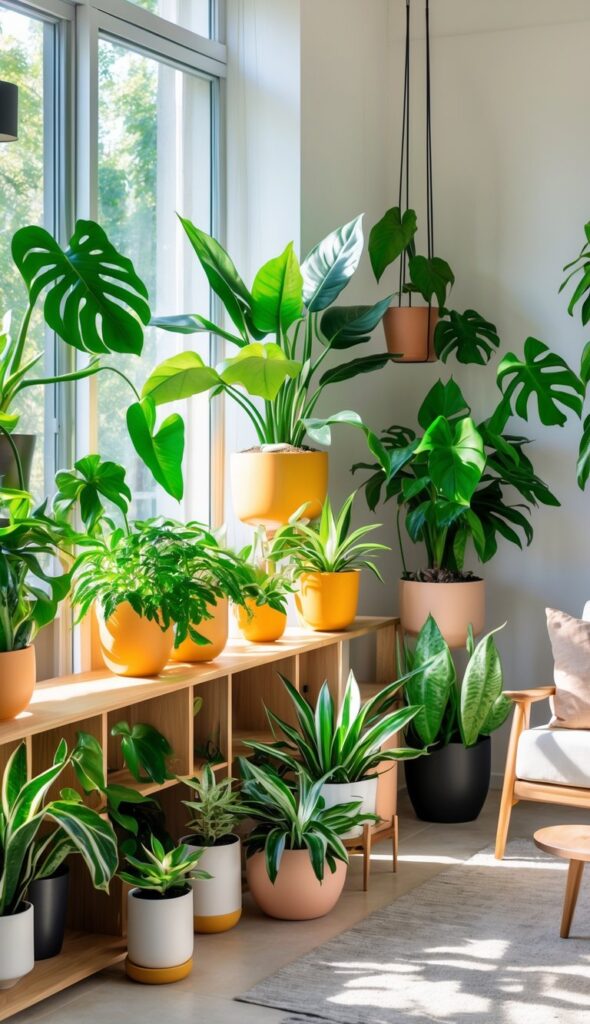
When I add plants to a room, I want them to feel like part of the space. I try to match their colors and sizes with what’s already there, instead of just tossing them in randomly.
Blending Plants With Interior Color Schemes
I like to pick plants that go with my room’s colors. If my walls are light blue, I’ll use green plants with a bluish hue or pots in soft shades like gray or white.
That way, the plants pop but don’t clash. Bold plants like a fiddle leaf fig bring in a strong green that looks great with neutral walls.
If my room already has a lot of color, I stick with softer green plants to keep things balanced. Pot color matters too—clay or wood works well in warm rooms, and sleek white or black pots look sharp in modern spaces.
Balancing Plant Placement in Different Room Sizes
In small rooms, I skip a bunch of tiny plants and pick one or two medium ones. A single big plant in the corner can fill space without making it feel packed.
I’m a fan of tall plants like snake plants or monstera—they take up less floor space and still make a statement. In bigger rooms, I’ll group plants to fill empty spots and add some life.
Shelves and side tables are perfect for layering plants and adding height. I always make sure I’m not blocking walkways or windows, since light is everything.
Mixing up pot sizes and plant heights keeps the room interesting. I always check for drainage holes in pots—nobody wants soggy roots.
Care and Maintenance for Displayed Plants
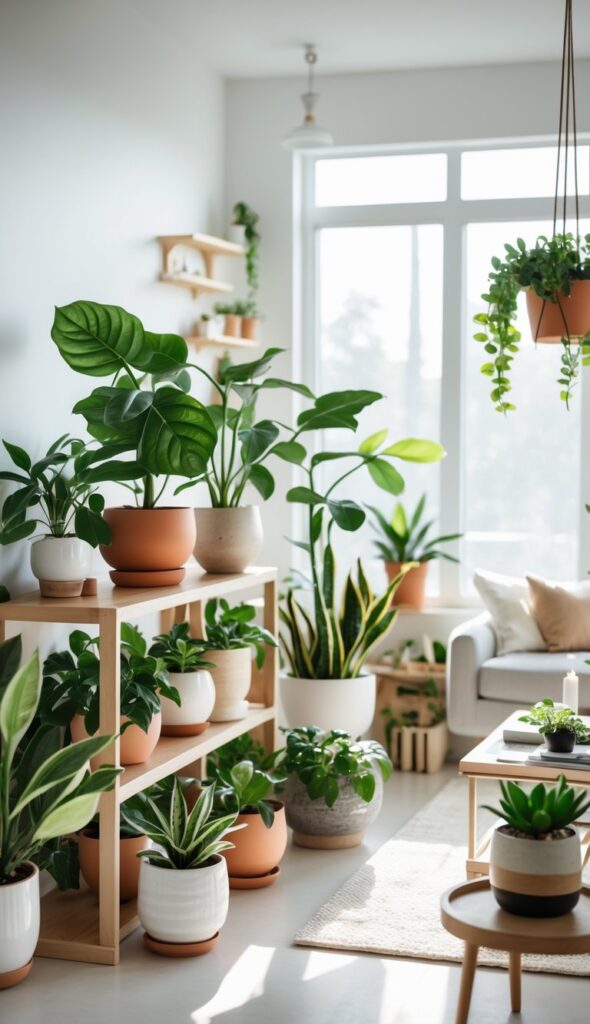
Taking care of plants on display mostly comes down to light and water. These two things make the biggest difference in how your plants look and feel.
Ensuring Healthy Lighting for Indoor Plants
Light is everything for plants. I try to give each one the right amount, depending on what it likes best.
Some, like ferns and calathea, are happier away from direct sun, so I tuck them in shadier spots. Others—think succulents or orchids—really want that bright, indirect light.
Here’s what I look for:
- Too much light: Leaves turn yellow or get crispy edges. Not a good look.
- Too little light: Leaves go pale or just start dropping off. Also not great.
Sometimes I’ll hang a sheer curtain to mellow out harsh sunlight, or move a plant closer to the window if it’s looking sad. If a room doesn’t get much natural light, I’ll add a grow light so my plants don’t give up on me.
Watering Strategies for Decorative Arrangements
Watering really depends on what kind of plant you’ve got and what it’s living in. I always poke my finger into the soil; if the top inch feels dry, that’s usually my cue to give it a drink.
Overwatering? Oh, that’s a classic mistake. I try not to just water on autopilot—I pay attention to how the soil feels instead.
Here are a few tips I swear by:
- Pots with drainage holes are a must. Otherwise, water just sits there and, well, roots get grumpy.
- If you’ve got ferns or orchids, they’ll thank you for a little mist now and then. They really dig that humidity.
- I like to group plants that need about the same amount of water. Makes life easier, honestly.
I keep a spray bottle and a watering can close by. It’s not fancy, but it works—I can give each plant just what it needs without worrying about floods or droughts in my living room.
